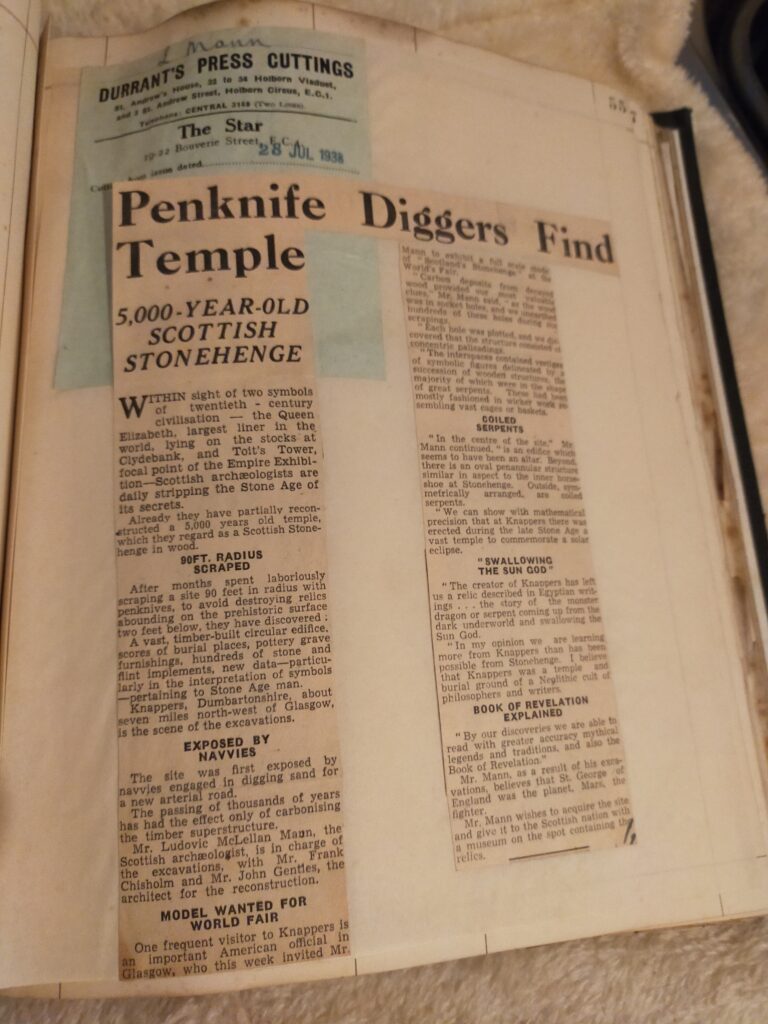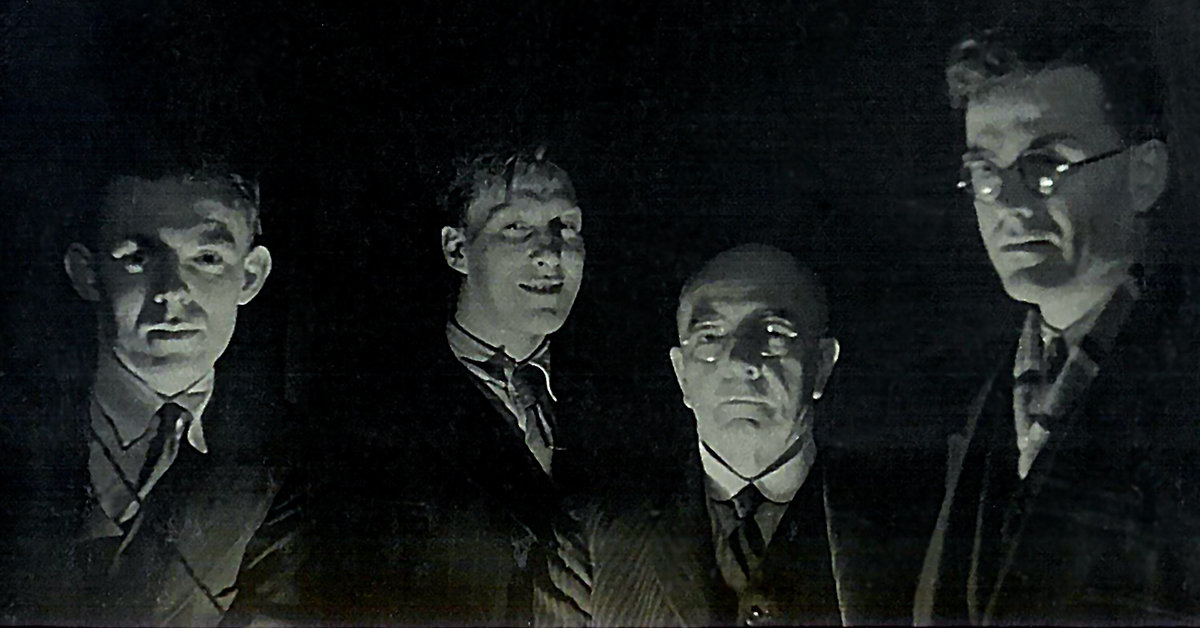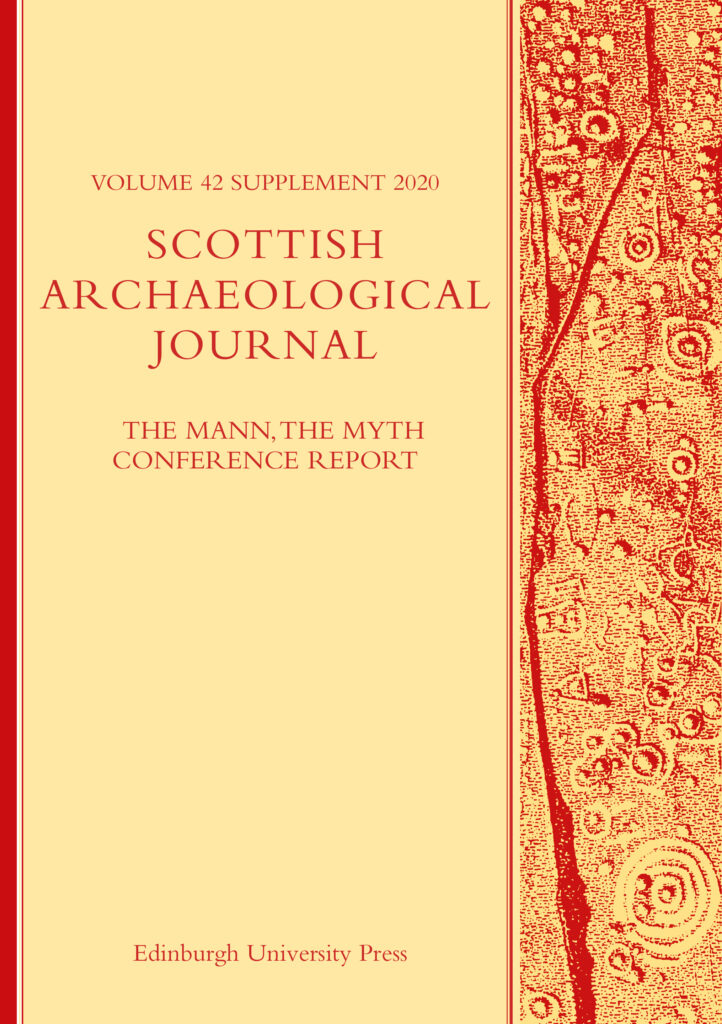
By Kenny Brophy
Decades before Instagram, YouTube, TikTok, and Twitter, to be an influencer involved analogue methods, persistence, and very, very hard work. Research over the last few years into the eccentric Glasgow-based amateur archaeologist, antiquarian and insurance broker, Ludovic McLellan Mann (1869 – 1955), suggests that he could be regarded as an early example of an influencer. Between 1911 and 1940 he became something of a celebrity in Glasgow and beyond through the tireless use of newspapers, the carefully cultivation of catchy soundbites, and shameless self-promotion.
The career and activities of Mann are the subject of a special supplemental edition of the Scottish Archaeological Journal (SAJ) recently published by Edinburgh University Press. This special edition, edited by Jim Mearns (editor of the Journal) and I, is a collection of papers first given during a conference exploring Mann’s legacy at the University of Glasgow in October 2018, The Mann the Myth. This event offered an opportunity to critically re-evaluate the work of someone whose reputation is polarised between those who believe him to have been a competent archaeologist ahead of his time, and those who feel he was a self-absorbed peddler of implausible theories about the past.

One of the most compelling contributions to the conference and the SAJ special edition was by George Applebey. George’s father, also called George Applebey, was a significant collaborator – and friend – of Ludovic Mann, assisting on some of Mann’s most famous excavations. George junior, as a boy, knew Mann, calling him Uncle Louis, and through a conference lecture and paper in the SAJ special edition George has offered invaluable insights into the dynamic intellectual context within which Mann worked.
George has shared with me a series of scrapbooks his father and Mann kept during their working collaboration. These contain hundreds of newspaper clippings that include proxy excavation reports, fund-raising bids, opinion pieces, and letters. One of these scrapbooks focused exclusively on Mann’s excavations in 1937 and 1938 at the Druid Temple site, Clydebank, West Dunbartonshire. This site, now under some high-rise flats on the south side of Great Western Road, consisted of a Neolithic timber setting and Bronze Age cemetery, dating to between 3000 and 1500 BC.

Mann promoted this site tirelessly, giving lectures to visitors to his excavations, reconstructing parts of the site, and trying to raise funds for its preservation. He also provided a lot of content for newspapers. In his contribution to the SAJ special edition, Jim Mearns notes the extent of Mann’s compulsive use of the print media throughout his career and in an earlier piece of biographical writing archaeologist Graham Ritchie[1] noted that Mann had almost constant contact with newspapers either providing them with press releases or availing himself of their newsclipping services. This is evident in the scrapbook which documents in effect a running commentary on what Mann was saying about the excavations.
Mann’s use of soundbites and carefully crafted press releases were his equivalent of memes and gifs. It is possible for instance using the scrapbook to follow catchy phrases and compelling ideas through the print media, spreading out across the UK, going viral. On 28th July 1938 for instance versions of the same story appeared in many newspapers all including several key colourful phrases – ‘Stone Age secrets’, ‘A Scottish Stonehenge’, ‘Digging with penknives’ – that were of course provided to them by Mann. Newspapers were in effect retweeting or sharing Mann’s copy, syndicating his soundbites.
The scrapbook includes page after page of stories headlined with one or more of these phrases published in The Star, Nottingham Evening Post, Edinburgh News, Edinburgh Dispatch, Scarborough Evening News and Post, Sheffield Evening Star, Paisley Daily Express, Yorkshire Telegraph & Star, Yorkshire Evening News, Belfast Telegraph, South Wales Argus, Yorkshire Evening Press, Norwich Evening Express, The Evening Citizen, North Western Daily Mail, The Nottingham Guardian, Huddersfield Examiner, Herald & Express (of Torquay), and The Northern Whig. The following day the same story appeared in The Scotsman, Nottingham Post, Birmingham Post, Gloucestershire Echo, Greenock Telegraph, and the News of the World.

These clippings are each accompanied by a blue ticket from Durant’s Press Cutting service, addressed to L Mann. So, Mann was collecting his own press cuttings, curating his own mythology, reinforcing his avatar as an ‘eminent archaeologist’ as he often called himself in the media, the 1930s analogue equivalent of an album of selfies stored in a cloud. Mann’s memorable narrative about his excavations was a gift for journalists, but also carefully timed to correspond with a broader media focus on Glasgow, as at this time, the recently completed Queen Elizabeth liner was in the docks at Clydebank (launched in September 1938), and the Empire Exhibition with Tait’s Tower was being held in the city’s Bellahouston Park.
The list of newspapers above read like an obituary for the print media, and there is huge potential for research within this and other archival material that was so well managed by George Applebey and family, beyond the interests of those with a fascination with the development of archaeology in Scotland. The SAJ supplement offers another routeway to further research and Jim and I are very much indebted to everyone who contributed to this publication and the conference.
Ludovic Mann belongs to a bygone age of amateur archaeology carried out by (mostly) men in suits and workmen in dungarees, as shown in many contemporary photos. But his methods of self-publicity seem curiously modern, with recognisable motivations that would surely have been perfect today in an age where society makes heroes of eccentric celebrities, people who are able to capture the zeitgeist, and communication depends as much on persistence and creativity as having something important to say. Ludovic Mann remains an influence on Scottish archaeology today, but during his career he was an influencer of a very different kind.
Author Biography: Kenny Brophy is a senior lecturer in archaeology in the University of Glasgow. His research interests include the contemporary archaeology of prehistory, the Neolithic period in Scotland, and anything quirky about Scottish archaeology. He blogs as the Urban Prehistorian. He also maintains a blog and website about Ludovic Mann.
[1] Ritchie, J N G 2002 Ludovic McLellan Mann (1869–1955): ‘the eminent archaeologist’ Proceedings of the Society of Antiquaries of Scotland 132, 43-64.
Scottish Archaeological Journal is the journal of the Glasgow Archaeological Society. The journal provides a thoughtful, scholarly perspective on Scottish archaeology, as well as neighbouring regions, from the earliest prehistory to the present. Articles in the journal report on fieldwork, discuss museum collections, consider the social and intellectual context of Scottish archaeology and document new discoveries. Find out how to subscribe, or recommend to your library.






